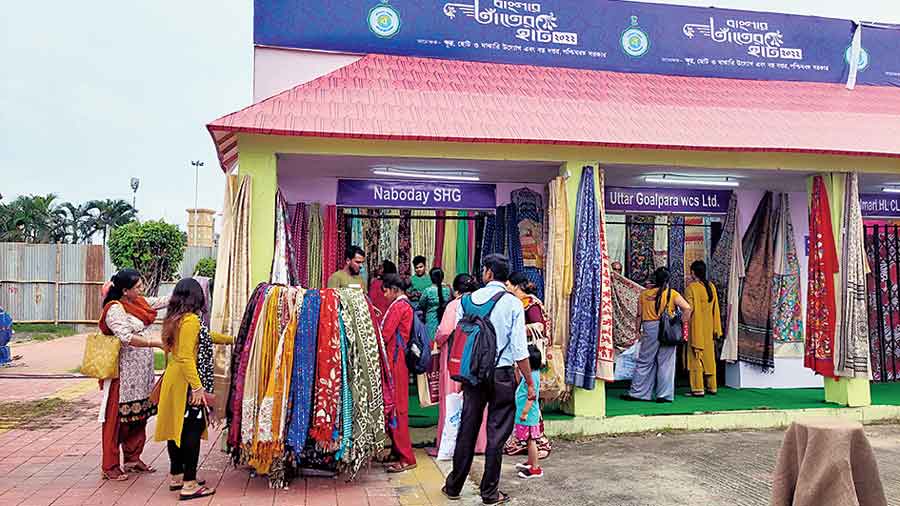For the past two years many revellers maintained a low profile during the Pujas, preferring not to buy new clothes as they wouldn’t really be going pandal-hopping or socialising. Not in 2022. This time, it’s okay to preen so people are set to shop till they drop.
Handloom saris
Taanter Haat, that is on till September 28 at Central Park, has been receiving steady footfall. “Taant jamdani is a big draw this year. Prices start at Rs 1,500 and can go up to Rs 5,000. Handloom saris always have a good market,” said Bijon Karmakar, a weaver who has come down from Nadia.
Bitan Biswas, another Nadia weaver, opines that even if the material remains cotton or handloom, designs and patterns change every year. “Customers browse through traditional jamdani weaves for the festive season but we must keep experimenting with the designs. For instance, I have taken the traditional ikkat design from Odisha and woven it into Santipur cotton sarees. That is new this year,” he said.
They have also adapted the Bhujodi sari patterns into the Santipur cotton gharana of saris this year. “This variety costs anything between Rs 2,000 and Rs 5,000, depending on the intricacies of the pattern. We also have budget cotton weaves beginning at Rs 800,” Biswas said.
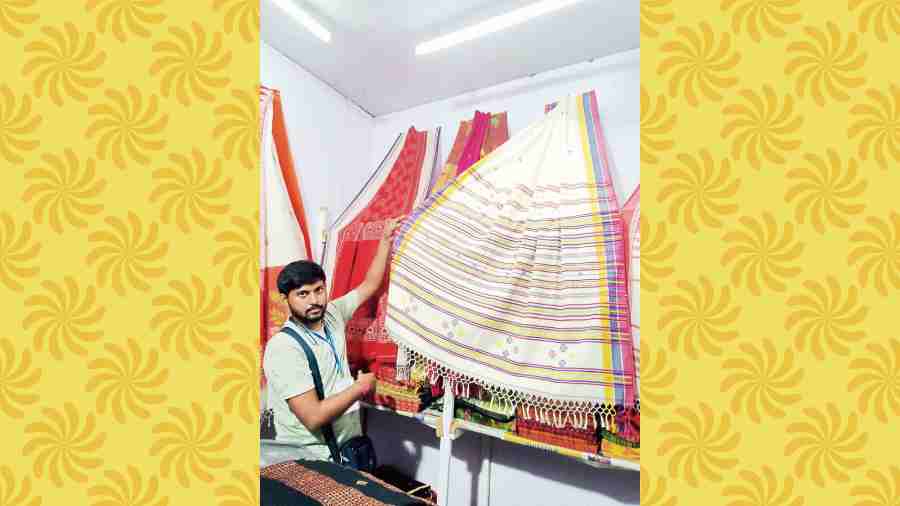
Bitan Biswas displays a white handloom sari with ikkat motifs at Taanter Haat.
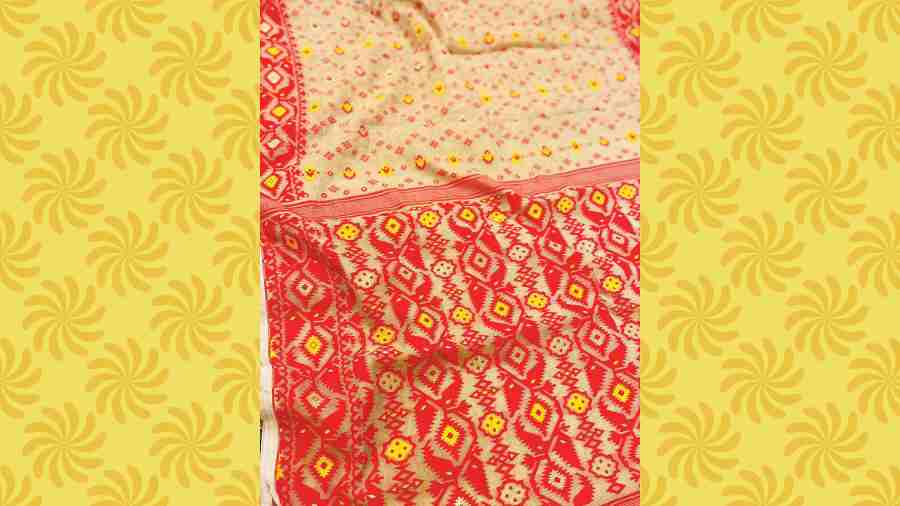
A jamdani sari
He agreed that handloom jamdani was the most popular buy this Puja. “There are several reasons for this. Over the last few years, customers have learnt to appreciate craftsmanship much more than they did earlier. They can now distinguish between a handloom jamdani and a machine-made jamdani. The latter is never pure cotton and is most likely to be polyester. However, a handloom jamdani is pure cotton and will not have any break in the continuous bunai or thread-work patterns. The entire sari is woven out of a single line of thread,” Biswas added.
Kalna-based national award winning weaver, Khokon Nandi, said inflation had played a big role in business this year. “One of the main reasons that saris are more expensive today is because every count of thread costs 20 to 30 per cent more than it did before the pandemic,” he said. “Even though customers have come to shop here, they are not willing to spend much money. I have been to fairs all over India and abroad, most of which are organised by the government. I have this particular design of jamdani on tussar and Bangalore silk which are huge hits.”
Sarada Mondal Saha from Birbhum said earlier people used to buy two or three saris. “Kantha stitch on Bangalore silk or katha on Bishnupuri silk are traditional favourites and they cost anything between Rs 5,000-9,000. But now people don’t want to buy expensive saris at all.”
Kurtis and gowns
Jhumpa Karmakar from Ranisha Boutique in DA Block has noted a huge spike in demand for two-piece kurta-pyjama sets or three piece kurta-pyjama-dupatta sets. “In the last 14 years that I have set up shop, this is the first time for such demand in these. Vintage Chanderi silk, muslin and ajrak prints have a good market now too. But no one is buying kalamkari. Even cotton gowns and silk oriental gowns are also doing well this year. Navy blue and bottle green shades are flying off the shelves,” she said.
Ankita Dutta, co-owner of Archisa Boutique in CD Block, said: “Ajrak printed silk and cotton saris and Bhagalpuri linen are in demand this year. This is because these materials are light and comfortable in summer. Customers are asking for these materials when it comes to dresses and gowns too. These days customers are conscious about dress material and will not wear something simply because it is fancy or good-looking. They will buy only if convinced about their durability,” she said.
Moumita Paul, who has set up a stall called Renuka Creations at Taanter Haat, said blouses with embroidery were also doing well. “Until last year, printed blouses were very popular but this time it’s embroidery, especially brightly coloured ones. You can pair any sari with a contrast blouse. You don’t need to match a sari with a blouse anymore!” she said.
In fact, blouses are often costlier than the saris they are worn with these days. “Prices range from Rs 550-650 per blouse. Patchwork blouses with ajkrak and kantha work cost around Rs 1,000,” said Paul.
Junk jewellery
When it comes to jewellery, junk still has a huge market throughout the year and demand peaks with silver and bronze oxidised pieces each year. This time, however, neckpieces with script patterns are in vogue.
“Script patterns along with kori designs lend an ethnic. A lot of people are buying these in bulk, especially to pair with kurtis and salwar kameez at my store,” said Karmakar from Ranisha Boutique.
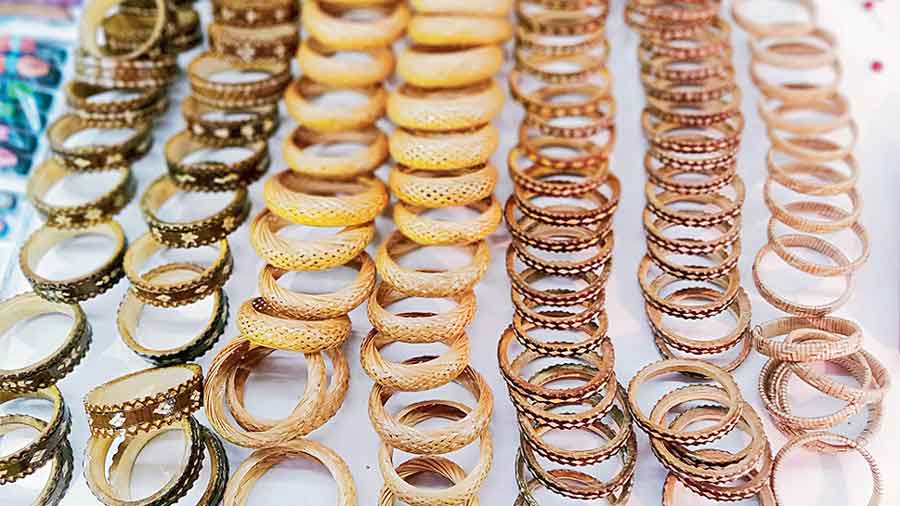
Bamboo bangles from Gajan, Malda
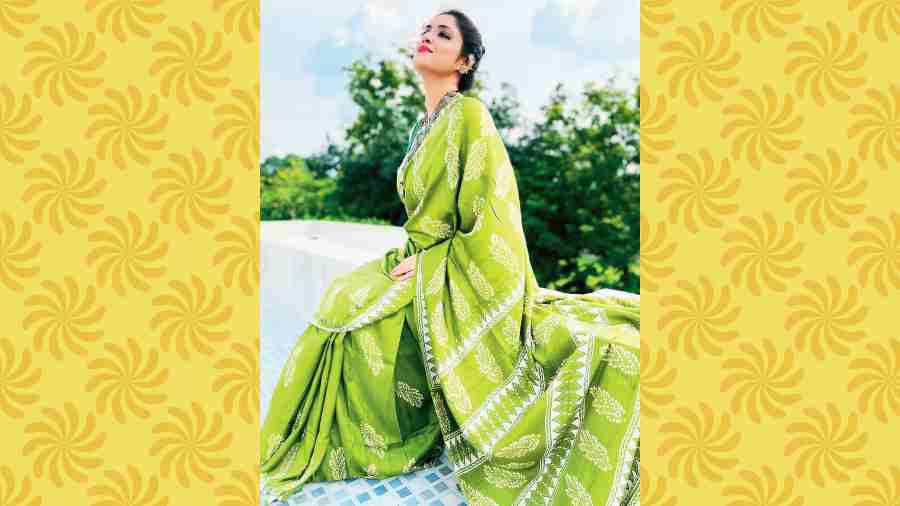
A green Bishnupuri katan silk

Durga motif necklaces at Taanter Haat
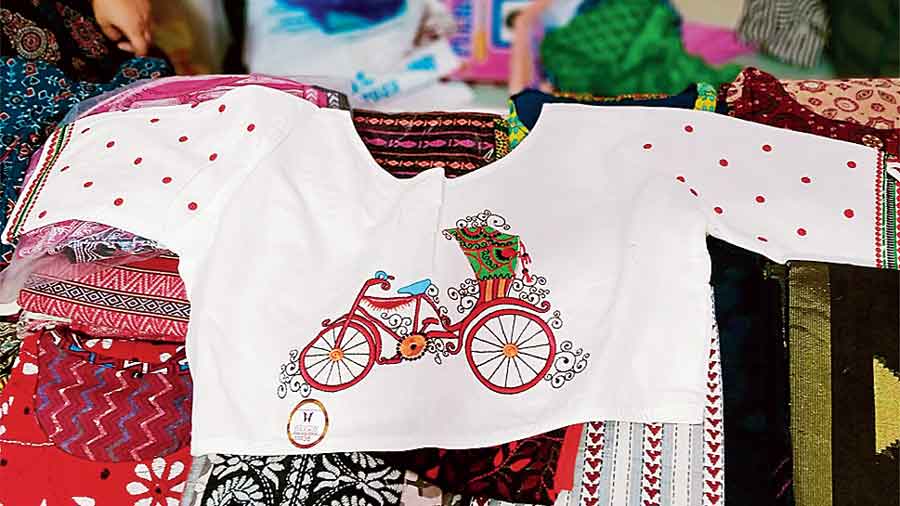
White and red blouse with embroidery is a big hit this season
One form of jewellery that caught the eye at Taater Haat is earpieces and necklaces made from fish fins. The fins are collected, dried and treated with chemicals at a workshop near Digha. They are then laid out for further heat treatment and once the chemical changes colour, designs are carved out with small knives and painted.
Rachana Saha, who has come from Digha with these, said her earrings cost Rs 200 and neckpieces start at Rs 300. “This is an eco-friendly art and we have recently developed this technique at our workshop. Most people back home are fishermen and instead of throwing the fins, we thought of upcycling them. The fisheries department helped us with it.”
The other popular items are jewellery made of bamboo shoots. Manik Das, who has come to the fair from Malda said: “There are many thin bamboo shoots available in our forests. We peel them off into narrow shapes and sizes and use them to make bangles, earrings and necklaces. It is part of our cultural heritage. They cost Rs 60-80 for bangles and Rs 150-200 for a full set of earrings and necklaces.”
